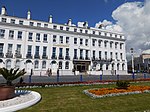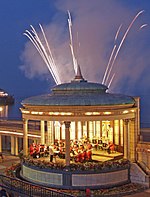Ashford Road
1857 establishments in EnglandCricket grounds in East SussexDefunct cricket grounds in EnglandDefunct sports venues in East SussexSport in Eastbourne ... and 2 more
Sports venues completed in 1857Use British English from February 2023
Ashford Road was a cricket ground in Eastbourne, Sussex. The first recorded match on the ground was in 1857, when Eastbourne played a United All-England Eleven. Sussex played Kent in the grounds first first-class match. The second and final first-class match held at the ground was played in 1873 and was between Sussex and Kent. The final recorded match held on the ground came in 1879 when the Eastbourne played E Christian's XI. The site is today occupied by buildings.
Excerpt from the Wikipedia article Ashford Road (License: CC BY-SA 3.0, Authors).Ashford Road
Leaf Road,
Geographical coordinates (GPS) Address Nearby Places Show on map
Geographical coordinates (GPS)
| Latitude | Longitude |
|---|---|
| N 50.77179 ° | E 0.28697 ° |
Address
Leaf Road
Leaf Road
BN21 3TX , Bridgemere
England, United Kingdom
Open on Google Maps









